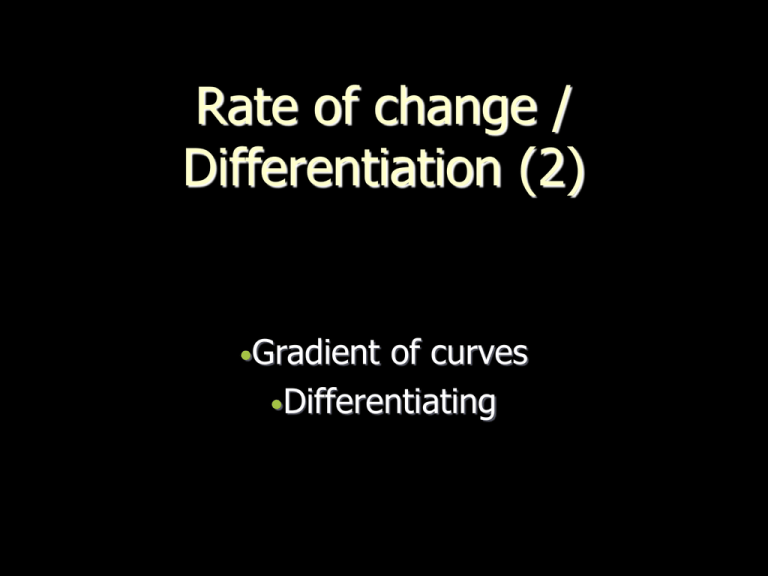x - Uplift Education
advertisement

Rate of change / Differentiation (2) •Gradient of curves •Differentiating Recall: A bit of new symbology y x dy dx dy dx = “difference in y” = gradient of line “difference in x” PRONOUNCED “dee-why by dee-ex” Gradient of Curves y=x2 The tangent to the curve gives the gradient at that point y Zoom (3,9) x Gradient = “difference in y” “difference in x” = 9.61 - 9 3.1 - 3 = 6.1 (3.1,3.12) B (3.1,9.61) A (3,9) Gradient of Curves y=x2 The tangent to the curve gives the gradient at that point y Zoom (3,9) x Gradient = “difference in y” “difference in x” = 9.0601 - 9 3.01 - 3 = 6.01 (3.01,3.012) B (3.01,9.0601) A (3,9) x 3 3.1 3.01 3.001 3.0001 3.00001 3.000001 3.0000001 3.00000001 3.000000001 y 9 9.61 9.0601 9.006001 9.00060001 9.00006 9.000006 9.0000006 9.00000006 9.000000006 dx dy 0.1 0.61 0.01 0.06 0 0.01 0 0 0 0 0 0 0 0 0 0 0 0 dy/dx 6.1 6.01 6.001 6.0001 6.00001 6.000001 6.0000001 6 6 As the interval in x decreases it tends to a definite value always twice ‘x’ A bit of theory y x (delta x) is the difference in the x coordinates Gradient = x y x As x gets smaller, it gives the gradient of the tangent dy dx More Terminology dy dx is the symbol used for the gradient of the curve The process of finding dy is called differentiating dx dy The gradient function dx is known as the derivative Graphs of displacement and gradient vs time s The curves of gradient are always one power lesss (in s x) than the original curves t t “y=mx+c” “y=ax2+bx+c” ds dt ds dt t “y=ax3+bx2+cx+d” ds dt t t “y=const.” “y=mx+c” t “y=ax2+bx+c” Lets do some differentiating The general rule (very important) is :- n x If y = dy = nxn-1 “Times by the power and reduce the power by 1” dx E.g. if y = x2 dy = 2x dx E.g. if y = x3 dy = 3x2 dx E.g. if y = 5x4 dy = 5 x 4x3 dx dy 3 = 20x dx Example 1 E.g. if y = x3 + 13x dy = 3x2 +13 dx You can just add them together So the gradient at x=3 is ….. dy dx = 3 x 32 +13 = 27 + 13 = 40 You just substitute the x value in Find dy for these functions :- Gradient at x=2 dx 3x2 dy = 6x dx = 12 y= x6 dy = 6x5 dx = 192 y= 5x5 dy = 25x4 dx = 400 y= 12x10 dy = 120x9 dx = y= x3 y= + x2 y = 6x3 + 3x2 + 11x dy = 3x2 + 2x = 12 +4 = 16 dx dy 2 + 6x + 11 = 18x dx =72+12+11 =95 Harder Examples E.g. if y = 3x(2x2 +9) Expand bracket first y = 6x3 +27x dy = 18x2 +27 dx 5x 4 8x 2 y 2x 5x 4 8x 2 y 2x 2x 5 3 Divide y x 4x through 2 dy 15 2 x 4 dx 2 1 y x x Express as fractional or negative indices 1 dy 1 2 x x 2 dx 2 1 2 yx x 1 The rules still work dy 1 1 2 dx 2 x x Harder Examples - your turn E.g. if y = 2x2(3x3 +x) Expand bracket first y = 6x5 +2x3 dy = 30x4 +6x2 dx 10 x 3 x 2 y 4x 10 x 3 x 2 y 4x 4x 5 2 1 Divide y x x 2 4 through dy 1 5x dx 4 3 3 y x 2 x Express as fractional or negative indices 2 dy 1 3 x 6 x 3 dx 3 1 3 y x 3x 2 The rules still work dy 1 6 3 dx 33 x 2 x







